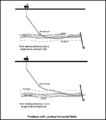Search results
Jump to navigation
Jump to search
Page title matches
- #REDIRECT [[Seismic data: two- or three-dimensional interpretation]]68 bytes (7 words) - 16:05, 21 November 2014
- 41 bytes (5 words) - 20:18, 30 January 2014
- ...lts, channels, and other features of interest. There will always be faults or channels oriented at angles between 0° and 45° relative to the orientatio8 KB (1,280 words) - 17:33, 25 January 2022
- 73 bytes (11 words) - 15:00, 28 June 2013
Page text matches
- ...969. For future and current events, use phrases such as as of January 2014 or since the beginning of 2010 to signal the time-dependence of the informatio If you must give information or data which will go stale in the future, please use the {{tl|update after}}678 bytes (112 words) - 21:38, 14 January 2014
- ...[economics]] and technologies change, yesterday's dry hole may be revived (or a twin to it may be drilled) to yield today's successful well.322 bytes (52 words) - 13:44, 18 March 2019
- ...ic log, usually in units of μs/ft or μs/m. It is also seen as ''delta t'' or ''Δt''.205 bytes (40 words) - 20:03, 14 April 2014
- ...r methanogenic) biodegradation during migration or while in the reservoir, or at surface seeps, typically at temeraptures approximately less than 80°791 bytes (108 words) - 19:58, 25 June 2015
- <!--If no or empty "demospace" parameter then detect namespace--> | <!--No "demospace" or "page" parameters, so detect actual namespace-->1 KB (119 words) - 12:59, 6 August 2013
- When making an edit or creating a new page on '''{{SITENAME}}''', contributors agree to these uses ...loads, for the purposes of tracking usage volume, diagnosing access issues or problems with the wiki server, and to administer the website.2 KB (333 words) - 15:37, 9 October 2013
- ...y and permeability. For instance, burrows filled with sand grains in a mud or clay unit could be conduits for fluid flow if connected. Bioturbation can o907 bytes (132 words) - 21:42, 18 September 2014
- ...ot contain oil or gas. Accumulations, or pools, are traps that contain oil or gas.<ref name=Vincelette>Vincelette, R. R., E. A. Beaumont, N. H. Foster, 2 ...s smaller than the carrier bed. The seal pore throat breakthrough pressure or the distance to the spill point of the trap, whichever is less, determines1 KB (206 words) - 17:37, 27 January 2015
- <!--If no or empty "page" parameter then detect | subsubpage <!--Subsubpage or lower-->757 bytes (63 words) - 21:26, 14 January 2014
- ...lly written as N25E, to distinguish it from dip, which is written 4S, 4SE, or 4 65SE.585 bytes (88 words) - 16:06, 11 September 2014
- ==Pages with missing or problematic figures==644 bytes (80 words) - 21:22, 1 June 2015
- ;Privacy policy: What one may or may not do with a user's data or behaviour. ;Copyrights: or '''Licensing''' — how people can use the content.3 KB (373 words) - 16:41, 31 July 2013
- ...hores), differences between two seismic events or reflections (isochrons), or any variables that can be mapped.540 bytes (69 words) - 20:24, 27 March 2015
- #REDIRECT [[Seismic data: two- or three-dimensional interpretation]]68 bytes (7 words) - 16:05, 21 November 2014
File:M91Ch13FG80.JPG ...can be used to pick likely fault planes in wells. Changes in dip amplitude or azimuth can indicate that a fault is present. Drag patterns may also be see(800 × 660 (102 KB)) - 21:14, 29 April 2015
File:Geological-heterogeneities fig2.png ...ermeability profiles of (a) fining- or thinning-upward and (b) coarsening- or thickening-upward sequences. ''Fining'' and ''coarsening'' refer to average(940 × 630 (40 KB)) - 15:35, 14 January 2014- '''HotCat''' allows registered users to quickly add or change categories.73 bytes (10 words) - 18:22, 17 January 2014
- ...remaining oil consists of saturates, aromatics, and nitrogen, sulfur, and/or oxygen (NSO) compounds.<ref name=Petersetal_2012>Peters, Kenneth E., David886 bytes (126 words) - 16:34, 25 June 2015

File:M106Ch12Table2b.jpg ...ce strata type: basinal marine (includes calcareous and marly lithologies) or basinal shale. Volumes of oil and gas in-place, estimated ultimate recovera(700 × 474 (70 KB)) - 15:30, 12 May 2016
File:M106Ch12Table2.jpg ...ce strata type: basinal marine (includes calcareous and marly lithologies) or basinal shale. Volumes of oil and gas in-place, estimated ultimate recovera(700 × 442 (69 KB)) - 15:28, 12 May 2016
File:M106Ch12Table2a.jpg ...ce strata type: basinal marine (includes calcareous and marly lithologies) or basinal shale. Volumes of oil and gas in-place, estimated ultimate recovera(700 × 515 (83 KB)) - 15:29, 12 May 2016
File:M106Ch12Table2c.jpg ...ce strata type: basinal marine (includes calcareous and marly lithologies) or basinal shale. Volumes of oil and gas in-place, estimated ultimate recovera(700 × 489 (73 KB)) - 15:30, 12 May 2016- ...h static web content, but is more akin to the AAPG's nascent blog channel, or its membership engagement functions. ...ted, content-oriented, and technical. They don't have to be a geoscientist or even a petroleum professional, but it would help.2 KB (294 words) - 16:44, 22 July 2013
- ...write it more simply and concisely by using the {{tlc|tlc}}, {{tlc|tld}}, or {{tlc|tlf}} templates. ...name use {{tlx|tl}} or {{tlx|tlx}}, and then use {{tlc|tlc}}, {{tlc|tld}} or {{tlc|tlf}} thereafter.726 bytes (127 words) - 17:38, 4 November 2013
- ...write it more simply and concisely by using the {{tlc|tlc}}, {{tlc|tld}}, or {{tlc|tlf}} templates. ...name use {{tlx|tl}} or {{tlx|tlx}}, and then use {{tlc|tlc}}, {{tlc|tld}} or {{tlc|tlf}} thereafter.726 bytes (127 words) - 17:38, 4 November 2013
- ...tion (look-ahead seismic profiles). Data can be transmitted to the surface or stored for later retrieval.2 KB (206 words) - 21:17, 3 December 2015
- ...m. It produces water only. Zero [[buoyancy pressure]] exists at this level or below.525 bytes (76 words) - 14:40, 8 September 2014
- ...e you mis-spelt it, or because it is missing from [[Template:Next period]] or [[Template:Period start]].</span>|{{Ma|{{{1|{{PAGENAME}} }}}|{{period start667 bytes (77 words) - 20:45, 4 November 2013
File:1024px-WaveRipple.JPG Wave ripple or symmetric ripple, from Permian rocks in Nomgon, Mongolia. Photo by Matt Aff(1,024 × 768 (251 KB)) - 20:29, 22 December 2014- ...ured (e.g., [[resinite]], [[sporinite]], or [[cutinite]]) and unstructured or amorphous liptinites, sometimes called [[amorphinite]], can occur.<ref name788 bytes (102 words) - 19:51, 25 June 2015
- The proposed classification scheme divides [[trap]]s into three main groups or systems, based on the controlling geologic element that created the trap: ...ure|syndepositional]] [[deformation]] or displacement of [[reservoir]] and/or [[seal]]ing units3 KB (405 words) - 17:44, 12 April 2022
- ...of the Content and shall not have any liability whatsoever for any direct or consequential damages resulting from the use of any information obtained th ...this Web site or cited, used or discussed in AAPG copyrighted publications or in presentations at events associated with AAPG.4 KB (654 words) - 18:31, 2 August 2013
- ...OR! Start of period {{{period}}} unknown, perhaps because it was mis-spelt or because it is missing from [[Template:Period start]].</span> ...ROR! End of period {{{period2}}} unknown, perhaps because it was mis-spelt or because it is missing from [[Template:Next period]].</span>653 bytes (83 words) - 20:49, 4 November 2013

File:Using-and-improving-surface-models-built-by-computer fig8.png Cross sections showing that surfaces that intersect due to (a) baselap or (b) truncation will incorrectly cross one another.(837 × 343 (9 KB)) - 22:32, 13 January 2014- ...entionally or may occur accidentally. A [[multilateral well|multilateral]] or [[multilevel well]] will have multiple intentional sidetracks drilled to pr1 KB (191 words) - 19:41, 3 March 2016
- This term refers to a vertical measure of the reservoir or trap containing hydrocarbons.165 bytes (22 words) - 19:51, 14 April 2014

File:ST53 Part01 Pg11A.jpg ...thin toward the structural high. Growth strata are generally folded in one or more limbs of the structure. In this seismic section, growth strata thin on(750 × 509 (230 KB)) - 16:23, 28 July 2015- ...ows definitions and examples for the classes and subclasses of these traps or trapping elements. ...ne or more sides by normal faults. Rotation traps hydrocarbons along edges or in corners.5 KB (740 words) - 16:04, 13 April 2022
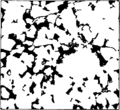
File:Reservoir-quality fig1.png ...raphic image of sandstone. Dark areas are pores and light areas are grains or cement.(950 × 868 (20 KB)) - 18:46, 14 January 2014- ...pture of details in sedimentary features for analysis away from the field, or for use in teaching.2 KB (239 words) - 19:40, 9 September 2014
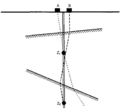
File:Checkshots-and-vertical-seismic-profiles fig3.png The source position (A or B) should be chosen so that the travel path to each receiver is as nearly v(945 × 875 (8 KB)) - 21:28, 13 January 2014- ...deasphalting is achieved by adding light hydrocarbons, such as [[pentane]] or [[hexane]], to the oil. A similar process can occur in nature when [[methan864 bytes (120 words) - 19:55, 25 June 2015
- ==User types or roles== | '''Root''' || 3 || Login || No || All || The person or people who can log into the server and edit LocalSettings.php2 KB (294 words) - 16:01, 6 August 2013
- ...ned [[sandston]]e might be classified as having intergranular mesoporosity or a [[limestone]] as having vuggy macroporosity. |Mega/macro || Clean, coarse sandstone or [[carbonate]] [[grainstone]] ||3 KB (442 words) - 13:52, 4 April 2022
- [[Diagenesis|Diagenetic]] traps occur in two basic categories: early or near-surface traps and late-burial traps. Early or near-surface diagenetic traps are created by the following:2 KB (294 words) - 21:01, 4 February 2022
- {{{ {{#if:{{{page|}}}| {{{page|}}} | {{FULLPAGENAME}} }} <!--Has data, or is empty but defined--> | <!--Else, are we on a subpage or a basepage?-->2 KB (203 words) - 18:59, 17 January 2014
- <!--"heading" not defined in this or previous level--> <!--"heading" has data or is empty but defined-->2 KB (205 words) - 13:38, 1 July 2014
File:M91Figure162.JPG ...encountered with landing a horizontal well if the target zone is too high or too low compared to what is predicted. From Chapter 28, AAPG Memoir 91, by(600 × 682 (38 KB)) - 19:32, 30 July 2014- A break or discontinuity in a process. An [[unconformity]] is the physical representa217 bytes (28 words) - 20:48, 25 August 2014
- Fluid-composition traps are controlled by the physical or chemical properties of the trapped fluids themselves. The [[Wikipedia:Solub ...[[asphalt]], [[tar]]) or solid hydrocarbons ([[albertite]], [[gilsonite]], or [[grahamite]]). || ''Tar Seals'' || ''Bacterial degradation;'' Updip tar se3 KB (402 words) - 16:31, 13 April 2022
- ...ts such as tilting or faulting, among others, a fold should have its crown or crest as the [[anticline]] and the trough of its structures as the syncline ...olded. This is the best term used to describe it rather than “downward arc or trough of a fold” this is because due to events when strata has been over3 KB (505 words) - 15:58, 21 March 2019
- When two or more distinct topics which share the same or similar title are being written about on the same page, even if they are cl To suggest article names (or more than one), simply pipe them into the template. For example, {{tlx|spli1 KB (221 words) - 16:46, 14 January 2014
File:M91Figure161.JPG ..., with the intent of keeping the well within a specific reservoir interval or hydrocarbon zone. From Chapter 28, AAPG Memoir 91, by Mike Shepherd(800 × 534 (36 KB)) - 19:25, 30 July 2014- ...[[uplift]]. Folds are expressed in [[seismic reflection profile]]s as one or more regions of dipping reflections ([[dip]] domains) that correspond to in ...hether or not the thickness of stratigraphic layers changes in dip domains or across axial surfaces.3 KB (495 words) - 15:09, 18 January 2016
- ...leum system. An oil or gas seep, a show of oil or gas in a well, or an oil or gas [[accumulation]] demonstrates the presence of a petroleum system.2 KB (298 words) - 18:35, 25 January 2022
- ...al geology, and various university departments and E&P companies favor one or another in their courses and approaches to problem-solving. The major appro * Detailed geometric and/or kinematic studies3 KB (422 words) - 20:17, 3 February 2022
- ...l analysis of clastic depositional systems#Shoreline deposits|shorelines]] or [[reef]]s. Mapping thickness of reservoir-quality rocks is also useful for ...ial for containing reservoir rocks, i.e., [[Third-order sequences|lowstand or highstand]], using biostratigraphic markers and regional correlation surfac4 KB (491 words) - 14:27, 21 March 2022
- ...tratigraphic correlation and age determination|biostratigraphic analysis]] or in a geographic array for [[Paleoenvironmental analysis|evaluating paleoenv * Records of species present or absent2 KB (268 words) - 15:18, 31 January 2022
- [[file:1024px-WaveRipple.JPG|thumb|300px|Wave ripple or symmetric ripple, from Permian rocks in Nomgon, Mongolia. Photo by [https:/372 bytes (51 words) - 22:00, 17 March 2015
- Time interval (or isotime or isochron) maps are commonly used for interpreting changes in thickness betw1 KB (135 words) - 14:13, 24 November 2015
- ...is article is unnecessary and can either be collapsed into another article or deleted entirely.[[User:Cwhitehurst|Cwhitehurst]] ([[User talk:Cwhitehurst|225 bytes (29 words) - 14:06, 16 December 2013

File:M31F3.jpg ...of braided channel deposits (letters on the vertical section refer to core or outcrop photographs). From Deltaic environments of deposition, 1981, Colema(2,941 × 1,884 (830 KB)) - 19:02, 15 August 2014- ...]], in which the well path is designed to change orientation from vertical or high-angle to horizontal.1 KB (173 words) - 15:33, 16 March 2016
- ...and the second (optional) one is a value for the first example parameter, or (if the first {{tl|para}} parameter is empty) an unnamed example parameter. ...lue (appearance as in example 3). When illustrating hypothetical, variable or user-definable values, use <tt><nowiki><var>value</var></nowiki></tt> (appe2 KB (243 words) - 20:59, 4 November 2013
- * This template adds a category or dated category to a page. * Parameter 4: Category all the articles go in, dated or not (if there is one).3 KB (550 words) - 20:59, 14 January 2014
- ...tation|content="Helper template for main page gallery. Takes one argument, or two for a renamed link. Option: '''size''' with units, e.g. ''size=24px''.}295 bytes (39 words) - 19:39, 1 April 2014
- ...ough the bend (curve) from vertical or high-angle to the desired low-angle or horizontal attitude.1 KB (174 words) - 19:33, 3 March 2016
- ...e or on the relative or absolute abundance of specific molecules in an oil or a [[source rock]] extract. ...can be obtained. In addition to correlating an oil directly to another oil or to a source rock extract, certain molecular parameters can be used to estim2 KB (294 words) - 21:02, 15 February 2022

File:Porosity fig3.png ...osity groups: fabric selective, not fabric selective, and fabric selective or not. (After Choquette and Pray, 1970.)(950 × 757 (24 KB)) - 18:19, 14 January 2014- Basement is rock below a sedimentary cover, often [[igneous]] or metamorphic. It is generally not of interest in exploration for oil and ga264 bytes (40 words) - 15:52, 10 March 2016
- <!--If no or empty "demospace" parameter then detect namespace-->409 bytes (42 words) - 01:17, 14 January 2014
- ...ale]] sequences. It is not applicable to massive [[carbonate]], [[chert]], or sandstone reservoirs. It has yet to be tested in interbedded shale–carbon ...th which a seal can be risked is thus much greater in a production setting or mature basin than it is in a frontier setting.3 KB (398 words) - 17:35, 29 March 2022
- ...refers to wells restricted to a platform or pad (because of environmental or economic contraints) that are attempting to access reserves at a significan1 KB (186 words) - 19:42, 3 March 2016
- ...erences, journals or ability to cut and paste an equation macro into excel or other applications *'''Printing''' - make it easy to print entire articles or selected subsets2 KB (266 words) - 15:49, 6 August 2013
- ...eologic element || Dominant control of the trap—structural, stratigraphic, or fluidic. ...sses? If the trap is fluidic, was closure formed by pressure, temperature, or chemical processes?5 KB (665 words) - 18:47, 12 April 2022
- <!--If no or empty "demospace" parameter then detect namespace-->435 bytes (45 words) - 18:11, 8 August 2013
File:M91Ch13FG82.JPG ...ed sections can be seen in a vertical well drilled through a reverse fault or with a highly deviated well penetrating a normal fault. From Shepherd, M.,(600 × 820 (92 KB)) - 21:16, 29 April 2015- A unique designation or name is important to identify a person, place, item, or idea. As geologists, we name rock units, fossils, uplifts, and basins. The | A positive [[Oil-oil and oil-source rock correlation|oil-source rock]] or gas-source rock correlation3 KB (367 words) - 18:35, 25 January 2022
- ...he structural system because fractures are a result of [[deformation]] and/or displacement and therefore are structural in nature. ...ractured rock or by change from open, permeable fractures to cement-filled or narrow-aperture, low-permeability fractures.3 KB (461 words) - 16:04, 13 April 2022
- ...into clusters. The results of the cluster analysis show faunal groupings, or ''biofacies'', which are often characteristic of specific environments. [[: ...r geologic data to determine or evaluate specific paleoenvironmental zones or settings.4 KB (493 words) - 20:00, 31 January 2022
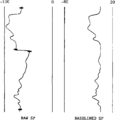
File:Log-analysis-applications fig2.png ...tive points, SP deflections are calculated and redisplayed as a baselined (or “static”) SP.(939 × 983 (9 KB)) - 16:36, 14 January 2014- Buoyancy is the tendency for a body (or a drop of immiscible fluid) to float or rise when submerged in a fluid of greater [[density]]. Where two immiscible ...re#Capillary pressure concepts|capillary effect]]s—such as a bottle, lake, or cave—the different fluids exhibit a sharp, flat interface.4 KB (596 words) - 18:37, 17 February 2022
- ...er area, to high-grade previously defined exploration leads and prospects, or to determine the type of petroleum (i.e., oil vs. gas) likely to be encount ...cal methods have previously been used successfully in the area of interest or in a geologic analog area?6 KB (809 words) - 17:05, 25 January 2022
- Fossil assemblages, or faunal assemblages, are simply groups of fossils found together in strata.484 bytes (58 words) - 20:11, 12 March 2015
- ...xploration for petroleum is the search for chemically identifiable surface or near-surface occurrences of hydrocarbons and their alteration products, whi * Hydrocarbon seepage can be active or passive and is visible (macroseepage) or only detectable analytically (microseepage).5 KB (687 words) - 19:23, 24 January 2022
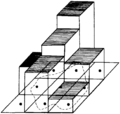
File:Using-and-improving-surface-models-built-by-computer fig18.png The cell is centered on the grid node and lies either inside or outside the polygon. The cell's area is multiplied by its z value (thicknes(835 × 790 (37 KB)) - 22:32, 13 January 2014
File:M31F25.jpg ...m between shot points and vertical scale is 10 milliseconds per time line, or 7.6 m (25 ft). Coleman, J. M., and D. B. Prior, 1981, Deltaic environments(1,087 × 1,348 (940 KB)) - 18:21, 18 August 2014- ...very real and can significantly affect the [[economics]] of an exploration or development program, the user must be aware of limitations associated with * False seep anomalies can be caused by reworked [[hydrocarbon]]s and/or reworked [[source rock]]s.3 KB (418 words) - 21:19, 24 January 2022
- ...g stubs into fuller articles. Very short stubs should be either built upon or deleted — if there is no real content, then links to the article should '''Introductory or definition''' material goes here. The name of the article should appear clo1 KB (192 words) - 14:22, 9 October 2013
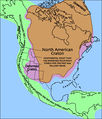
File:NacratonUSGS.jpg ...million years or so. Continents can grow when two plates collide, welding, or accreting, the two pieces together. Continents also grow when oceanic crust(512 × 599 (332 KB)) - 15:27, 19 August 2014- ...rocarbon migration|Migration]] to the surface, either from a [[reservoir]] or [[source rock]]. Also called dismigration.440 bytes (58 words) - 21:47, 25 June 2015
- * '''Trap seal'''—an impediment or barrier that interferes with hydrocarbon [[migration]] from the reservoir. ...en reservoir and seal, or (2) boundaries between fluids, such as oil–water or gas–water contacts. Temperature can also control a trap boundary as displ4 KB (614 words) - 17:02, 12 April 2022
- | align="center"| ± || plus or minus || 0177 || Shift = || &plusmn; || \pm | align="center"| ≥ || greater or equal || 242 || . || &ge; || \geq2 KB (296 words) - 16:57, 14 January 2014
- ...ee common source rock evaluation errors made by geologists during prospect or play appraisals]: AAPG Bulletin, vol. 93, issue 3, pp. 341-356.</ref>]] ...in thermally immature rocks; dominated by organic matter that was recycled or extensively oxidized during deposition. Sometimes the type IV pathway is no1 KB (185 words) - 21:11, 6 July 2015
- ...p. 219-235.</ref> || rowspan = 2 | ''Local anticline'' || ''Fault bounded or cross faulted'' || ''Relief, symmetry, internal faulting, internal geometry ...rom the horizontal in one direction only and are not a part of a anticline or syncline.<ref name=ch02r11>Rittenhouse, G., 1972, [http://archives.datapage6 KB (742 words) - 14:42, 13 April 2022
- ...ect, regardless of local structural style, level of structural complexity, or exploration maturity: ...tratigraphic thickness variation or has behaved in a [[Ductility|ductile]] or compactive manner during [[deformation]].4 KB (504 words) - 14:17, 2 February 2022
- ...hic, structural, or fluidic traps. But many traps are a combination of two or three geologic elements. In these traps, basic trapping elements occur in c1 KB (191 words) - 18:46, 12 April 2022
- ...-D pore system geometries found in intergranular, intercrystalline, vuggy, or fractured rocks. ...-D pore system geometries found in intergranular, intercrystalline, vuggy, or fractured rocks. Copyright: Coalson et al.;<ref>Coalson, E. B., S. M. Gools3 KB (388 words) - 13:52, 4 April 2022
File:M91Ch13FG94.JPG ...on in areas with thick delta sequences and mobile substrates such as shale or salt. This example is from Upper Triassic deltaic sediments exposed in the(800 × 345 (49 KB)) - 21:41, 29 April 2015- ...h. Basin-fill analysis is looking for [[Stratigraphic trap|stratigraphic]] or [[combination trap]]s by combining [[paleogeography]] with the results of t1 KB (189 words) - 18:53, 4 February 2022


